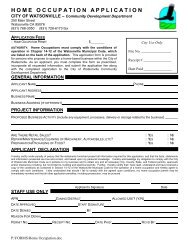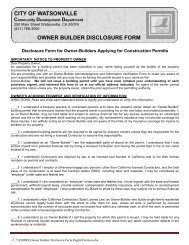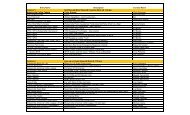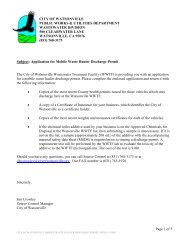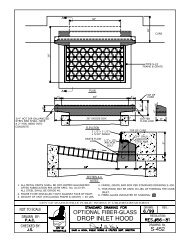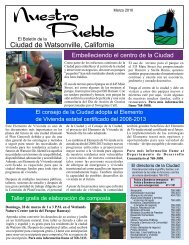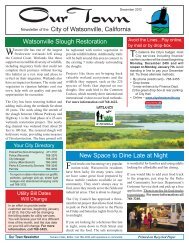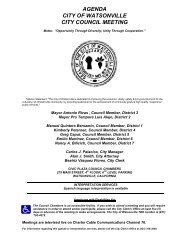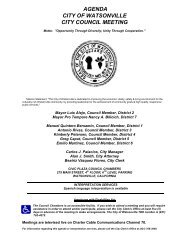Vegetation Management and Maintenance Plan - Watsonville ...
Vegetation Management and Maintenance Plan - Watsonville ...
Vegetation Management and Maintenance Plan - Watsonville ...
You also want an ePaper? Increase the reach of your titles
YUMPU automatically turns print PDFs into web optimized ePapers that Google loves.
General Rules for Grubbing<br />
• If the plant has gone to flower, the floral heads should be bagged <strong>and</strong> removed for proper<br />
disposal.<br />
• If the plant has runners (rhizomes or stolens) all parts of the plant should be bagged <strong>and</strong><br />
removed for disposal.<br />
• If plants are to be root cut, they should be cut below the root crown (greater than 2”<br />
below the surface) <strong>and</strong> prior to flowering.<br />
• Small to moderate woody stem plants may be girdled, if it is safe to do so <strong>and</strong> you are<br />
unable to efficiently dig them up.<br />
• If you are not sure if a plant is an invasive species, do not remove it until it has been<br />
identified.<br />
• If you see an animal in the area that you suspect may be protected (e.g., Santa Cruz longtoes<br />
salam<strong>and</strong>er, California red-legged frog), do not work in the immediate area until the<br />
animal has been identified.<br />
There are a number of h<strong>and</strong> tools that are widely used for grubbing specific types of invasive<br />
plants. Commonly used tools include:<br />
• Weed Wrench - This tool is used to remove woody-stemmed plants with minimal soil<br />
disturbance. Examples include French broom, young acacias <strong>and</strong> young eucalyptus.<br />
• Rakes - Rakes may be used to remove lose biomass, establish clear perimeters or remove<br />
dense non-woody spreading plants or vines. Examples include cape ivy <strong>and</strong> iceplant.<br />
• McLeod/fire rake - These tools are used to clear areas to bare earth for controllable<br />
perimeters or when utilizing the Bradley Method.<br />
• Pulaski/h<strong>and</strong> pick - These tools can be used like an axe, hoe, small shovel, or pick to cut<br />
large or woody plants, clear earth, dig holes, or girdle trees.<br />
• Round-pointed shovel - Depending on type, shovels are efficient for cutting roots,<br />
exposing rhizomes, establishing perimeters, or making hole for plantings.<br />
• Soil knife- A soil knife is useful for exposing <strong>and</strong> cutting the roots of individual plants or<br />
small patches of plants. This tool can be easily carried in a pouch.<br />
• Scythe/h<strong>and</strong> scythe - The scythe is not commonly used, as it requires proper training in<br />
both use <strong>and</strong> sharpening. However, the scythe is increasingly being used to cut grasses, as<br />
it is proving to be faster, quieter, <strong>and</strong> more effective than weed whipping when the proper<br />
technique is developed. The h<strong>and</strong> scythe is useful for small areas of grass, in sensitive<br />
areas. Use of the h<strong>and</strong> scythe does not require any training.<br />
• Axes, saws, loppers <strong>and</strong> pruners - These tools are used to remove woody-stemmed plants<br />
or large/tough stemmed herbaceous plants, such as late season thistles.<br />
• Serrated knife- Knives can be carried at all times <strong>and</strong> used to cut, saw, or girdle small<br />
woody-stemmed plants or tough stemmed herbaceous plants.<br />
• Strapping or chains- These can be used with vehicles, come-alongs, or winches to pull<br />
plants such as pampas grass out of the ground.<br />
• Hoes- Discussed below.<br />
3.1.3 Hoeing<br />
Hoeing invasive weeds is an effective technique to remove small groups of plants <strong>and</strong>/or<br />
individual occurrences.<br />
Typically, hoeing should occur prior to flowering, with the plant cut 2-4” below the ground<br />
surface. If flowers are on the plant, the cut/removed material should be bagged <strong>and</strong> removed from<br />
the site. If no flower heads have formed, the cut material can be left on site, with the possible<br />
exception of poison hemlock. Hoeing can be used at all times of the year, although plant removal<br />
<strong>Vegetation</strong> <strong>Management</strong> <strong>and</strong> <strong>Maintenance</strong> Manual<br />
Draft 16 July 27, 2007




